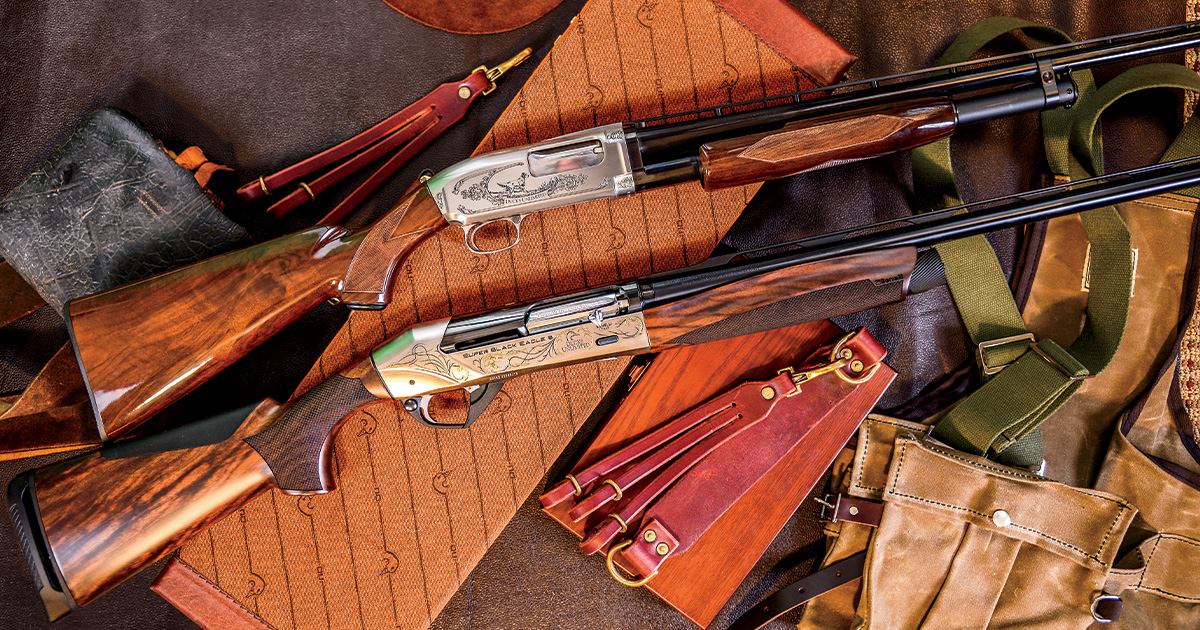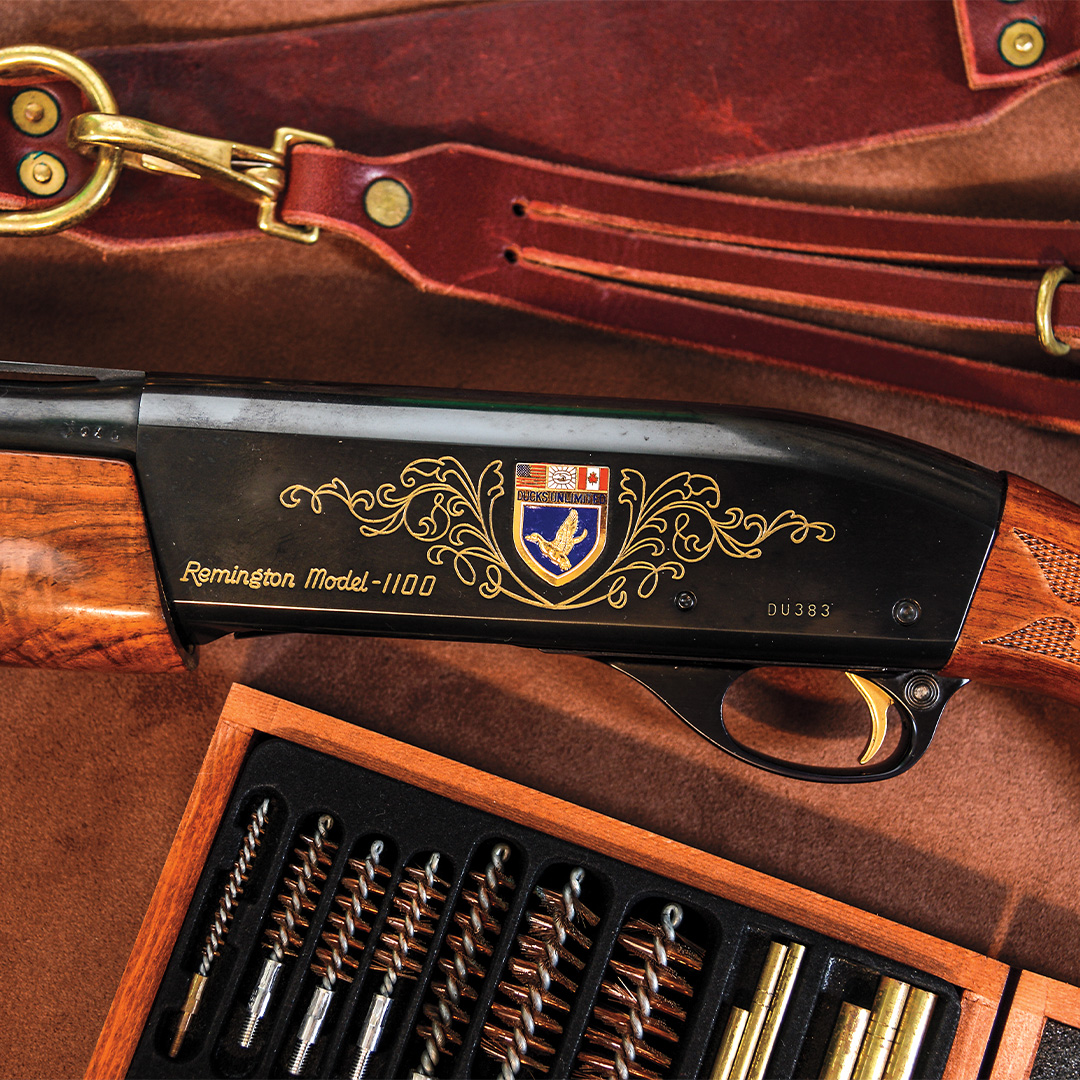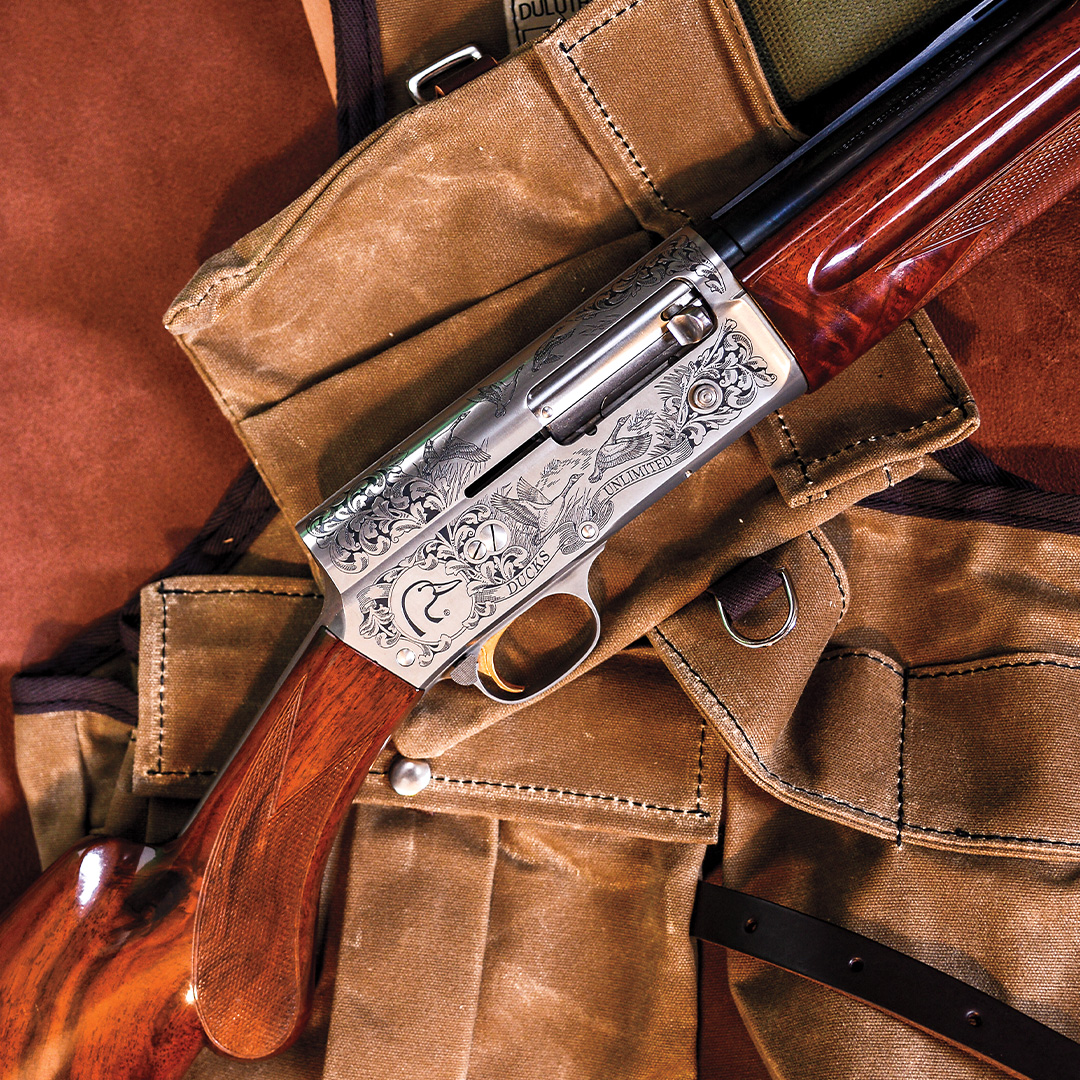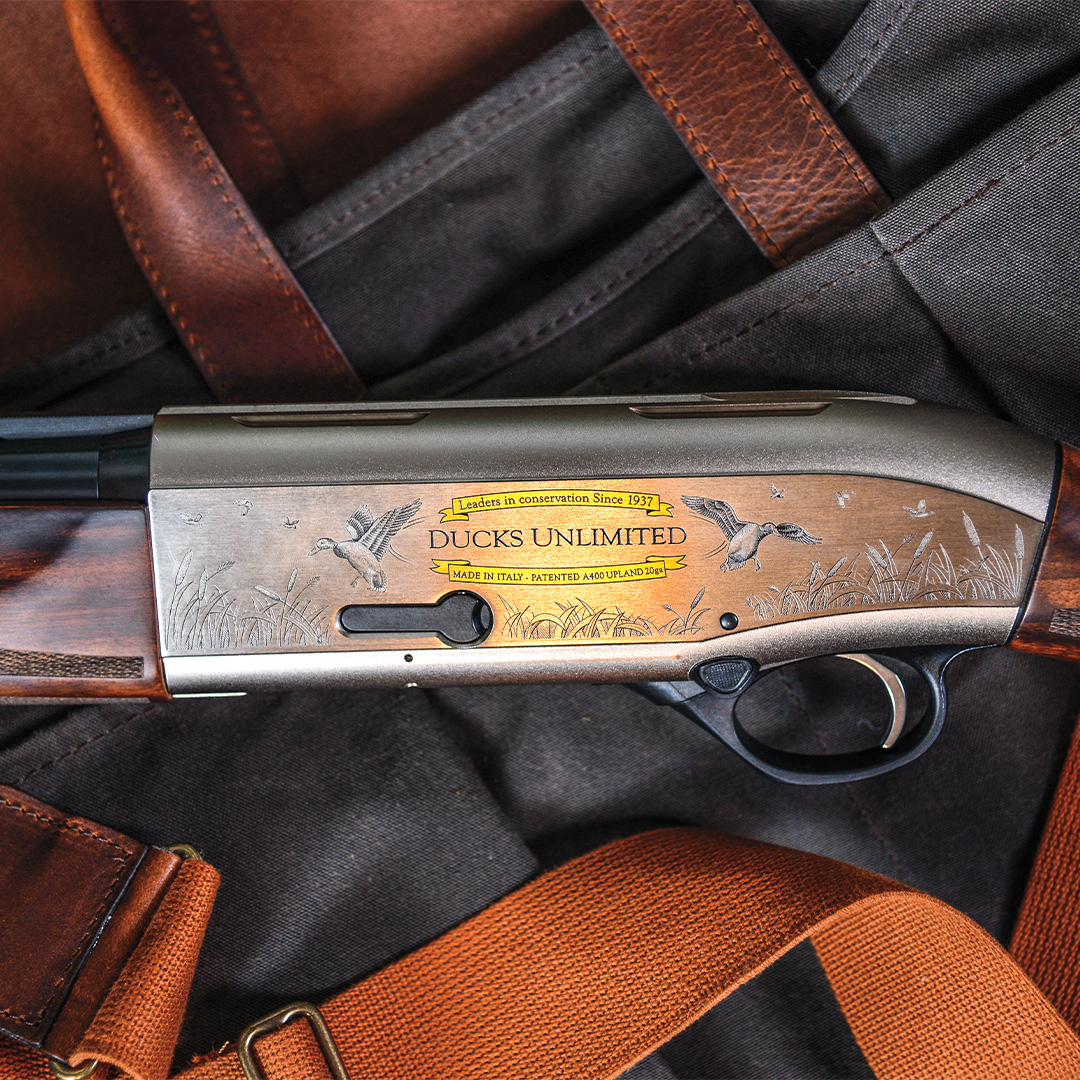Modern Classics
DU’s Gun of the Year program has been going strong for half a century. Here’s a look at some of the most memorable shotguns in the collection
DU’s Gun of the Year program has been going strong for half a century. Here’s a look at some of the most memorable shotguns in the collection

Photography by John Hoffman

This year marks the 50th anniversary of Ducks Unlimited’s Gun of the Year program, which has raised more than $250 million for wetlands and waterfowl conservation. In 1973, DU’s first Gun of the Year was a lavishly decorated Remington 1100, and it set the pattern for the popular program of custom guns that are only available through DU events. Made in a limited edition of 500, with serial numbers DU1 to DU500, that first gun featured upgraded wood, a special DU logo, a hard case, and other embellishments. Underneath the decoration, it was a 12-gauge with a 30-inch full choke barrel—a popular configuration in the lead-shot days of the early ’70s. It was a hunting gun as well as a banquet prize.
There was another good reason for picking the 1100 as the first DU Gun of the Year: Remington’s revolutionary semiauto was 10 years old at the time and was already seen as a classic waterfowl gun. In the long and successful history of the program, DU has always chosen top-quality shotguns to receive Gun of the Year upgrades. Beneath their engraved receivers and fancy walnut stocks, many of them are classic duck and goose guns. To preserve their collectible value, some have been squirreled away without ever being fired, but more than a few have gone to the blind with their owners, and any of them could. Here is a selection of some especially noteworthy shotguns that have helped DU raise money for its important conservation mission.
DU Gun of the Year in 1973, 1981–82, 1985–86

Introduced in 1963, the 1100 could be called the first truly modern shotgun, as it was designed with the aid of computers and mass-produced with common and stamped parts. There had been gas-operated semiautos before the 1100, but none that worked as reliably. Its soft recoil, combined with a stock that fit a wide range of shooters, made it an immediate hit with target shooters and hunters. It became an instant success and remained a state-of-the-art gas gun until the introduction of the 11-87 (DU’s 1998–99 and 2006–07 Guns of the Year), which is essentially the same gun with a metered gas valve that allows it to shoot 2 3/4- and 3-inch shells without adjustment.

In 1973, the Remington 1100 became DU’s first Gun of the Year. The 12-gauge semiauto featured gilded gold inlay and a full-color DU crest on the receiver.
DU Gun of the Year in 1974, 1982–83

DU followed the first Gun of the Year with the 1100’s stablemate—the 870 pump. Introduced in 1950, the 870 was as revolutionary as the 1100 was. It replaced the Model 31, a machined, hand-fitted pump legendary for its smoothness. The 870 was part of a family of shotguns and rifles that used several common parts to save money. Other parts were made of stamped metal where possible. But instead of making a cheap gun, Remington built an affordable, durable classic, and the engineers who designed it didn’t neglect fit and handling. It had a stock that fit most people, and the 12-gauge was actually built on the receiver of a 16-gauge 11-48 semiauto, making it trim and easy to point. The 870 went on to be built by the millions, and it was the first gun offered by newly resurrected RemArms last year.
DU Gun of the Year in 1975, 1993–94, 1995–96

Considered by many to be the greatest pump shotgun ever made, the Model 12 was produced from 1912 to 1964, then made as “Y” models with some cast parts through the 1970s. During its long run, the Model 12 was offered in trap, skeet, hunting, and military versions. Shooters loved it because the action was slick, especially when compared to its predecessor, the Model 1897, and because it pointed so naturally, thanks to a slim forearm, low-profile receiver, and a grip that kept the front and rear hands on the same plane. The 1975 DU version had a target-style forearm in place of the classic corncob, but it was definitely a waterfowl gun, with a 2 3/4-inch chamber and a 30-inch full choke barrel. Browning made a run of Miroku-built Model 12s in the ’90s, and that gun became a DU Gun of the Year in 1995–96.
DU Gun of the Year in 1976

At a time when manufacturers were learning how to make guns at lower cost, the Super-X Model 1 was a throwback. Winchester had cut costs drastically across its product lines in 1964, resulting in shotguns like the inexpensive and much-maligned Model 1400 semiauto, which was made with alloy and some plastic parts. The gun-buying public was not pleased, and Winchester addressed those concerns in 1968, when work began on a gun to compete with the Remington 1100. Five years in the making, the Super-X Model 1 was a beautifully machined and finished all-steel gas semiauto. Made in skeet, trap, and hunting models, it looked elegant, recoiled softly, and worked reliably. Journalists and shooters praised it, but the gun cost too much to produce, and it lasted only until 1981.
DU Gun of the Year in 1977

Ithaca waited until all the patents ran out on the Model 17 Remington designed by John Browning and Harold Pedersen, then introduced their own bottom-ejecting pump in 1937—the same year that DU was founded. The result was the classic Ithaca Model 37 pump, which became a favorite of hunters who preferred a lightweight, bottom-ejecting pump, and its durability made it a military and law-enforcement success as well. The Model 37 survived bankruptcies and changes in ownership to come back from the dead many times, and it’s the only pre-WWII pump still made today. Production moved from New York to Ohio after a change in ownership. The newer guns are very well made, and, unlike older 37s, they are available in 3-inch chamberings.
DU Gun of the Year in 1984–85, 1996–97, 1999–2000, 2002–03

In 1977, Browning introduced a pump gun inspired by John Browning’s designs. Bottom-ejecting guns like the BPS admit less debris into their actions than side-eject guns, which have both ejection and loading ports, and they are often preferred by left-handed shooters. To make the design even more useful to lefties, Browning gave the BPS a top-tang safety. The BPS’s fit and finish meet Browning’s usual high standards. Since 1977 it has been made in trap, slug, turkey, and field models and in a variety of gauges. It’s also one of only two production 10-gauges left on the market.
DU Gun of the Year in 1986–87, 1987–88

If you see a gas semiauto at a South American dove lodge or a sporting-clays shoot, it’s likely to be a Beretta. Beretta guns earned their reputation for reliability in those two high-volume arenas, and they have also served reliably in duck blinds across the United States. The guns of the 300 series—the A300, A301, A302, and A303—established Beretta as a maker of gas guns that rivaled the Remington 1100. Each of the 300s was just a few tweaks better than the preceding model. The A303 debuted in 1985, and it was the first Beretta semiauto with interchangeable choke tubes. Some duck hunters and many sporting clays shooters insist that the A303 is the best gas gun ever made.
DU Gun of the Year in 1987, 1988–89 (Sweet Sixteen), 1990–91


Browning’s Auto-5 was an easy choice for DU’s 50th anniversary Gun of the Year. The first successful semiauto shotgun, it was patented at the turn of the 20th century, and plenty of today’s hunters believe it’s the best autoloader ever made. Browning’s brilliant invention used the long-recoil system, in which the barrel and bolt travel together the full length of the shell, and adjustable friction rings, which allow it to shoot a wide range of loads. It was distinctive, reliable, and far ahead of its time. The Auto-5 was made in standard and magnum 12- and 20-gauge models. The scaled-down Sweet Sixteen version was a favorite of quail hunters and some timber duck hunters, and it was the DU Gun of the Year following the 50th anniversary. Made in Japan’s Miroku factory, both of the Auto-5 DU Guns of the Year have tough barrels that can shoot steel if you want to take either of these gems to the blind.

The Browning Auto-5 Sweet Sixteen was the DU Gun of the Year in 1988-89. It sported detailed engraving and a barrel that is safe for steel shot.
DU Gun of the Year in 1991–92, 2000–01

With the A390, introduced in 1992, Beretta caught up with the trend of manufacturing “all-load” semiautos, which were pioneered by Remington with the 11-87. We take it for granted today that any semiauto will cycle 2 3/4-, 3-, and sometimes 3 1/2-inch shells interchangeably, but before all-load semiautos were developed, you had to switch between 2 3/4- and 3-inch barrels. The A390 shot everything you put in it, all the way down to the lightest reloads, and it would shoot reliably without much maintenance. After the A391 replaced the A390, Beretta built budget A390s in the United States called the AL3901, which were some of the best deals ever offered to duck hunters. The 3901, although an affordable gun, cleaned up beautifully with high-grade walnut and an engraved, inlaid silver receiver when it was named DU Gun of the Year for 2011.
DU Gun of the Year in 2004–05

By the 1990s, one-time competitors Browning and Winchester had become sister brands under the same ownership. Winchester’s Super X2 had the lines of the classic Super-X Model 1, including its sloping vent rib and receiver design, but its insides were almost identical to those of Browning’s first truly successful gas gun—the Gold. Soft-shooting and very easy to clean, the Super X2 also drew on hard lessons Browning learned with the 3 1/2-inch version of the Gold, and it functioned reliably with heavy magnums and target loads alike. It was eventually replaced with the Super X3, which put the same proven design in a lighter, sleeker package and itself was named the DU Gun of the Year in 2010. It, in turn, was replaced by the Super X4, which is one of best buys in a gas gun today.
DU Gun of the Year in 2005–06, 2008, 2009

One of only two over/under models ever chosen as DU Gun of the Year, the Beretta White Onyx is a classic in its own right. Part of Beretta’s 680-series over/under line, the White Onyx features the same bulletproof action and low-profile receiver that has made Beretta stack-barrels into worldwide favorites among hunters and target shooters. Made to be easily rebuilt, 680-series guns can last for generations of hunting use and have won at the highest levels of clays competitions too. DU chose the 12-gauge White Onyx as its first over/under Gun of the Year, then followed up with 20- and 28-gauge models, creating a collectible set.
DU Gun of the Year in 2012

The Gun of the Year during DU’s 75th anniversary celebration was the Browning Maxus. Essentially a second-generation version of the Gold, the Maxus debuted in 2009. It featured an improved gas piston design, trimmer lines, and a unique forearm latch that eliminated the magazine cap and gave the gun a sleek appearance. And while the 3 1/2-inch Gold had problems when it first appeared, the Maxus performed admirably from the very beginning. It also felt better in hand than the bulkier Gold did. It had distinct 21st-century styling but retained time-honored Browning features such as the magazine cut-off and two-piece speed-load carrier originally invented by John Browning for the Auto-5. Browning recently released the Maxus II, adding a magazine cap that allows the gun to be fitted with an extended magazine for snow geese and a soft comb that reduces the gun’s mild recoil even more.
DU Gun of the Year in 2014

It’s no exaggeration to say that Benelli’s inertia-operated semiautos changed waterfowling. Because they don’t use gas from the action to operate, inertia guns stay cleaner longer and can take the abuse of duck hunting in stride. In 1987, before there was a 3 1/2-inch shell or a Super Black Eagle, Benelli introduced the Montefeltro Super 90, which was one of the first Benelli models to appear in the United States. Renamed simply “Montefeltro” in 2012, it has long been a choice of hunters who want a lively inertia gun but prefer more traditional lines. The Montefeltro performs just as well in the uplands as it does in the duck blind, and its graceful looks made it a perfect candidate for DU Gun of the Year upgrades, which included an engraved gold-inlaid receiver and high-grade walnut.
DU Gun of the Year in 2015, 2018 (Sweet Sixteen)

With its distinctive square-backed receiver and, of course, its name, the A5 recalls John Browning’s classic Auto-5. Inside, however, it’s a totally different gun. Work began on the A5 design as soon as Benelli’s patents protecting its inertia design expired. The A5 combines the clean-shooting reliability and light weight of inertia guns with Browning styling. And it comes with handy features like the speed-load two-piece carrier and the Turnkey magazine plug, which comes out easily with the use of a car key. Browning followed up the initial success of the A5 with a Sweet Sixteen version that became a huge hit. It’s a scaled-down lightweight gun that almost single-handedly jump-started a 16-gauge revival among upland and waterfowl hunters.
DU Gun of the Year in 2016, 2020, 2021


Beretta’s A400, introduced in 2010, has become one of the most popular high-end semiautos among waterfowlers. The A400 combines features of the Xtrema 3 1/2-inch gun, such as the action spring mounted on the magazine tube, with the proven design of the A391 and added some tweaks of its own. Its gas operation works with the very effective stock-mounted Kick-Off recoil reducer to ease the recoil of 3 1/2-inch magnums. Like Beretta gas guns before it, the A400 is at home on the sporting clays course and in the South American dove field, which speaks to its reliability. Originally debuting as a 3 1/2-inch magnum, it is now made in 3-inch 12-gauge, 20-gauge, and 28-gauge, as well as an Xtreme Plus 3 1/2-inch waterfowl gun with enlarged controls and other features added with the waterfowler in mind.

DU’s 2021 Gun of the Year was the Beretta A400 Upland 20-gauge. The sister of DU’s 2020 Gun of the Year, it featured gold-enhanced engraving on the satin-finished silver receiver.
DU Gun of the Year in 2019, 2022, 2023

The original Super Black Eagle (SBE), introduced in 1991, was the first semiautomatic shotgun made for a 3 1/2-inch 12-gauge cartridge. Serious duck hunters discovered it and decided it was worth its premium price, and it became the prestige gun for a duck hunter to own, earning the nickname “Arkansas Purdey.” Soon the SBE was a household name among waterfowlers. Benelli continues to refine its flagship gun. The SBE 3 is lighter and slimmer than its predecessors and includes improvements like a next-generation recoil-reducing stock and a patented easy-locking bolt that can’t be bumped out of battery. With the success of the SBE, Benelli has filled out the line with 3-inch 12-, 20-, and 28-gauge models. A 20-gauge model was selected as the 2022 DU Gun of the Year, and for 2023, a 28-gauge joins the lineup, offering collectors a unique opportunity to own a trio of custom DU SBEs.
Ducks Unlimited uses cookies to enhance your browsing experience, optimize site functionality, analyze traffic, and deliver personalized advertising through third parties. By continuing to use this site, you agree to our use of cookies. View Privacy Policy